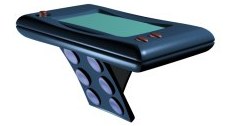www.gkos.com
GKOS Typing Speed
1. After a small amount of practice, the typing speed exceeds that of the GSM number pad method (multi-tap).2. It is quite easy to reach a typing speed of 100 characters per minute (20 wpm)
3. When fully familiar with the keyboard, a typing speed of 200 chars/min (40 wpm) is obtained.
4. Final expert typing speed can be around 300 chars/min (60 wpm)
The typing speed naturally depends on the physical GKOS keyboard implementation and the type of keys. The figures above have been tested and surpassed in practice, except for the 60 wpm. The typed text in the tests included letters and punctuation only ("ordinary text").
Even these figures can be exceeded by skilful typists by applying the GKOS chordon technique which allows partly parallel entering of characters (see the classification below).
It is interesting to notice that typing without looking at the text output on the screen, gives slightly higher text entry speeds when you are fully familiar with the GKOS system. The visual feedback seems to add its own part to the time consumed to type a character. If you do not see the text you are producing it is easier to think ahead of the letter just being typed and typing feels more fluent.
For rough comparison, here are speeds in WPM (words per minute) for some common text entry methods:
200 Normal speech and Stenograph (a chordic shorthand keyboard used in US courts)
170 Guinness record level (touch typing on a Dvorak keyboard)
120 QWERTY top level expert (touch typing)
60 QWERTY expert (touch typing)
50 GKOS record by now (chording)
40 GKOS expert (chording)
40 Typical good QWERTY user (touch typing or hunt and peck)
40 HalfQwerty expert (chording)
30 Mini QWERTY average (hunt and peck of course)
25-35 Handwriting on paper (experienced writers)
25 Stylus on screen avrg (QWERTY layout)
15 PDA handwriting detect average
14 GSM predictive average
9 GSM multitap average
Some general thoughts about typing speeds - why are keyboards diffrent in speed
If no intelligent software is used to predict and complete words that are being typed (but, unambiguously, one press produces one letter), there are different cases to consider regarding keyboards and their speed:
1. A parallel keyboard with a dedicated key for each letter - THE FASTESTOrdinary QWERTY and Dvorak physical keyboards are examples of this category. This is the fastest method because the next key can most of the time be pressed before the previous is released (= parallel operation). Being able to type consecutive letters with alternate hands may increase speed in some situations. The maximum possible speed is mainly determined by the amount of movement of fingers required to reach different keys.Optimising the keyboard in this respect, however, only gives marginal improvement in practical speeds because moving cannot be completely eliminated due to the large number of keys.
2. A serial keyboard not requiring moving of fingers to other positions - NEXT TO FASTEST
Some chording keyboards are examples this (like GKOS when not using the 'chordon technique'). The fingers can be at the same position all the time. (There are chording keyboards that quite often require moving e.g. your thumbs between different keys causing some slowing down of typing.) Most of the time, it is required to release the previous keys before typing the next character (= serial operation). In this category, some characters may require extra keystrokes, changing to an upper case letter for example but, on the other hand, no time is spent for continuously moving fingers to other positions.
3. A serial keyboard with a dedicated key for each letter - NEXT
Some virtual keyboards are examples of this category. Tapping letters on the display by a stylus for example requires both leaving the previous key and moving the stylus to another postion before typing the next character. In this category, too, some characters may require extra keystrokes, like changing to an upper case letter.
4. A serial keyboard requiring more actions than just pressing or tapping to define the character - NEXT
Some virtual keyboards are examples of this category. Selecting letters on the display by a stylus for example first requires leaving the previous key, moving the stylus to another postion and then often moving the stylus on the display to define the letter .
There are, of cource, keyboards with different combinations of the features above, or including other features, but their possible maximum typing speed can often be considered according to the main principles above. The size of the keys is also an important factor in both physical and virtual keyboards because time is also consumed for targetting the stylus or fingers towards the keys.It is hard or even useless to compare the indicated achievable typing speeds for different types or brands of keyboards because the ways to measure or estimate their performance vary a lot and the information given tends to be biased in favor of the presented method
chording keyboard typing speed - chordic keyboard typing speed - chord keyboard typing speed- combination keyboard typing speed - multipress keyboard typing speed
